HRM Report: Employee Engagement, Management Practices, and Theories
VerifiedAdded on 2022/09/12
|15
|3605
|24
Report
AI Summary
This comprehensive report delves into the crucial aspects of Human Resource Management, focusing on employee engagement, people management theories, and their impact on organizational performance. The report begins with a reflective statement highlighting the importance for line managers to understand the relationship between employee engagement and organizational performance, the significance of knowledge about people management theories, the ability to select appropriate management practices, and ways to improve competitive advantage. Part two of the report presents a management report based on a journal article, discussing the importance of a true learning culture for organizational sustainability, the benefits and challenges of line managers encouraging continuous development, the role of line managers in facilitating employee development, and recommendations for senior leadership to promote a learning culture. The report emphasizes the importance of diversity, inclusion, and effective people management practices in driving organizational success, including a case study on Sainsbury's and its approach to human resource management. The report underscores the significance of employee engagement, continuous learning, and proactive management in achieving sustainable competitive advantage.
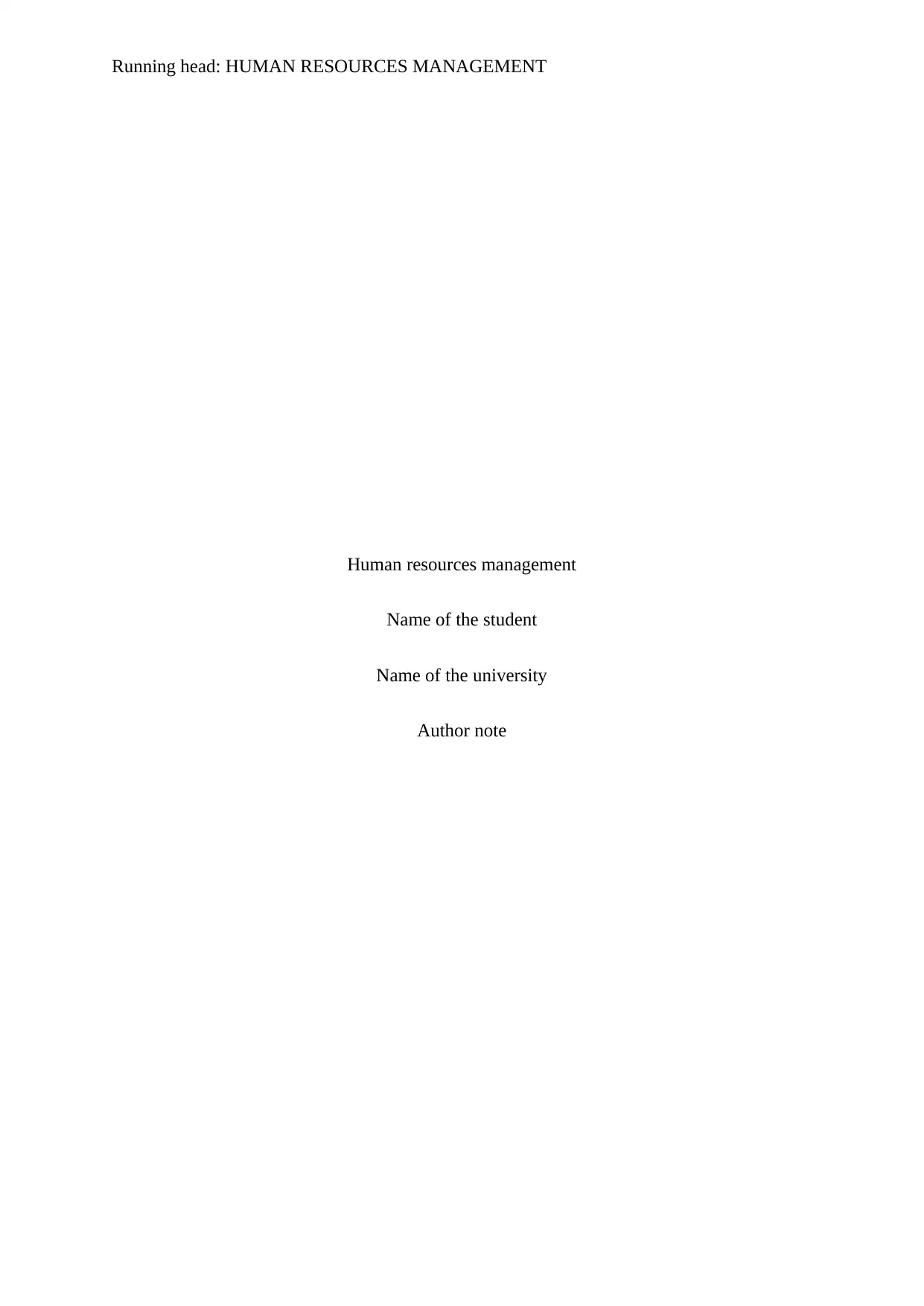
Running head: HUMAN RESOURCES MANAGEMENT
Human resources management
Name of the student
Name of the university
Author note
Human resources management
Name of the student
Name of the university
Author note
Paraphrase This Document
Need a fresh take? Get an instant paraphrase of this document with our AI Paraphraser
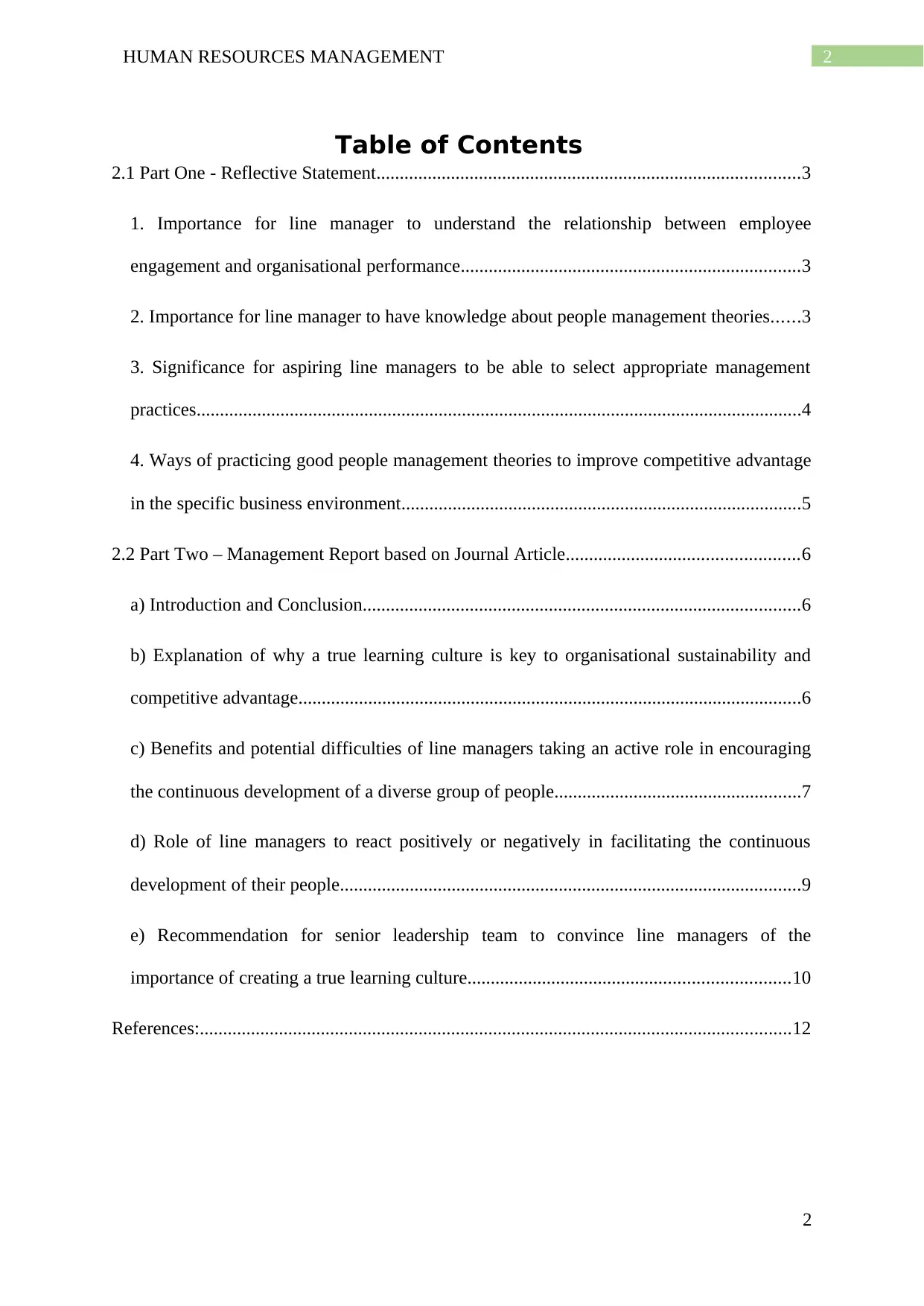
2HUMAN RESOURCES MANAGEMENT
Table of Contents
2.1 Part One - Reflective Statement...........................................................................................3
1. Importance for line manager to understand the relationship between employee
engagement and organisational performance.........................................................................3
2. Importance for line manager to have knowledge about people management theories......3
3. Significance for aspiring line managers to be able to select appropriate management
practices..................................................................................................................................4
4. Ways of practicing good people management theories to improve competitive advantage
in the specific business environment......................................................................................5
2.2 Part Two – Management Report based on Journal Article..................................................6
a) Introduction and Conclusion..............................................................................................6
b) Explanation of why a true learning culture is key to organisational sustainability and
competitive advantage............................................................................................................6
c) Benefits and potential difficulties of line managers taking an active role in encouraging
the continuous development of a diverse group of people.....................................................7
d) Role of line managers to react positively or negatively in facilitating the continuous
development of their people...................................................................................................9
e) Recommendation for senior leadership team to convince line managers of the
importance of creating a true learning culture.....................................................................10
References:...............................................................................................................................12
2
Table of Contents
2.1 Part One - Reflective Statement...........................................................................................3
1. Importance for line manager to understand the relationship between employee
engagement and organisational performance.........................................................................3
2. Importance for line manager to have knowledge about people management theories......3
3. Significance for aspiring line managers to be able to select appropriate management
practices..................................................................................................................................4
4. Ways of practicing good people management theories to improve competitive advantage
in the specific business environment......................................................................................5
2.2 Part Two – Management Report based on Journal Article..................................................6
a) Introduction and Conclusion..............................................................................................6
b) Explanation of why a true learning culture is key to organisational sustainability and
competitive advantage............................................................................................................6
c) Benefits and potential difficulties of line managers taking an active role in encouraging
the continuous development of a diverse group of people.....................................................7
d) Role of line managers to react positively or negatively in facilitating the continuous
development of their people...................................................................................................9
e) Recommendation for senior leadership team to convince line managers of the
importance of creating a true learning culture.....................................................................10
References:...............................................................................................................................12
2
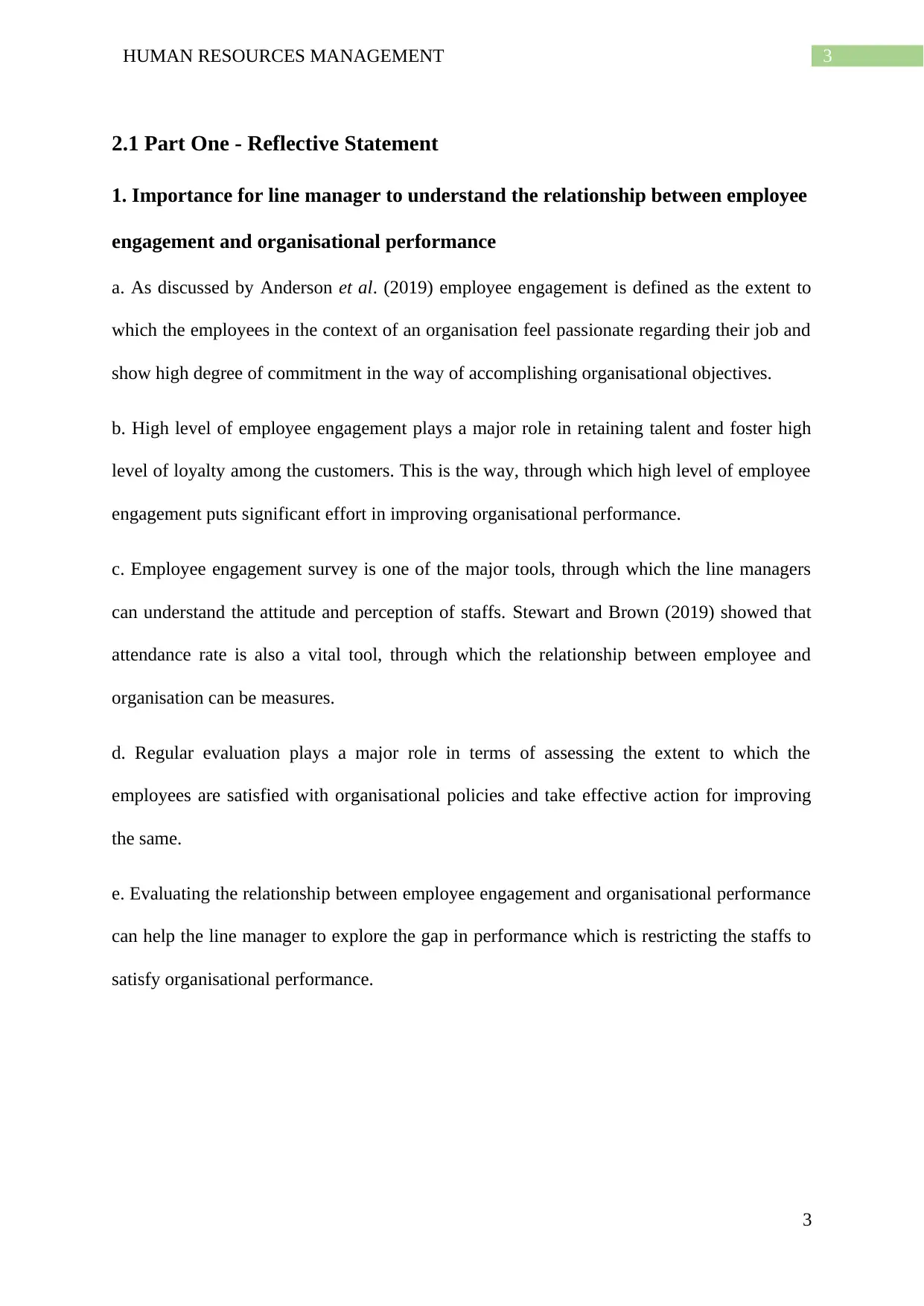
3HUMAN RESOURCES MANAGEMENT
2.1 Part One - Reflective Statement
1. Importance for line manager to understand the relationship between employee
engagement and organisational performance
a. As discussed by Anderson et al. (2019) employee engagement is defined as the extent to
which the employees in the context of an organisation feel passionate regarding their job and
show high degree of commitment in the way of accomplishing organisational objectives.
b. High level of employee engagement plays a major role in retaining talent and foster high
level of loyalty among the customers. This is the way, through which high level of employee
engagement puts significant effort in improving organisational performance.
c. Employee engagement survey is one of the major tools, through which the line managers
can understand the attitude and perception of staffs. Stewart and Brown (2019) showed that
attendance rate is also a vital tool, through which the relationship between employee and
organisation can be measures.
d. Regular evaluation plays a major role in terms of assessing the extent to which the
employees are satisfied with organisational policies and take effective action for improving
the same.
e. Evaluating the relationship between employee engagement and organisational performance
can help the line manager to explore the gap in performance which is restricting the staffs to
satisfy organisational performance.
3
2.1 Part One - Reflective Statement
1. Importance for line manager to understand the relationship between employee
engagement and organisational performance
a. As discussed by Anderson et al. (2019) employee engagement is defined as the extent to
which the employees in the context of an organisation feel passionate regarding their job and
show high degree of commitment in the way of accomplishing organisational objectives.
b. High level of employee engagement plays a major role in retaining talent and foster high
level of loyalty among the customers. This is the way, through which high level of employee
engagement puts significant effort in improving organisational performance.
c. Employee engagement survey is one of the major tools, through which the line managers
can understand the attitude and perception of staffs. Stewart and Brown (2019) showed that
attendance rate is also a vital tool, through which the relationship between employee and
organisation can be measures.
d. Regular evaluation plays a major role in terms of assessing the extent to which the
employees are satisfied with organisational policies and take effective action for improving
the same.
e. Evaluating the relationship between employee engagement and organisational performance
can help the line manager to explore the gap in performance which is restricting the staffs to
satisfy organisational performance.
3
⊘ This is a preview!⊘
Do you want full access?
Subscribe today to unlock all pages.

Trusted by 1+ million students worldwide
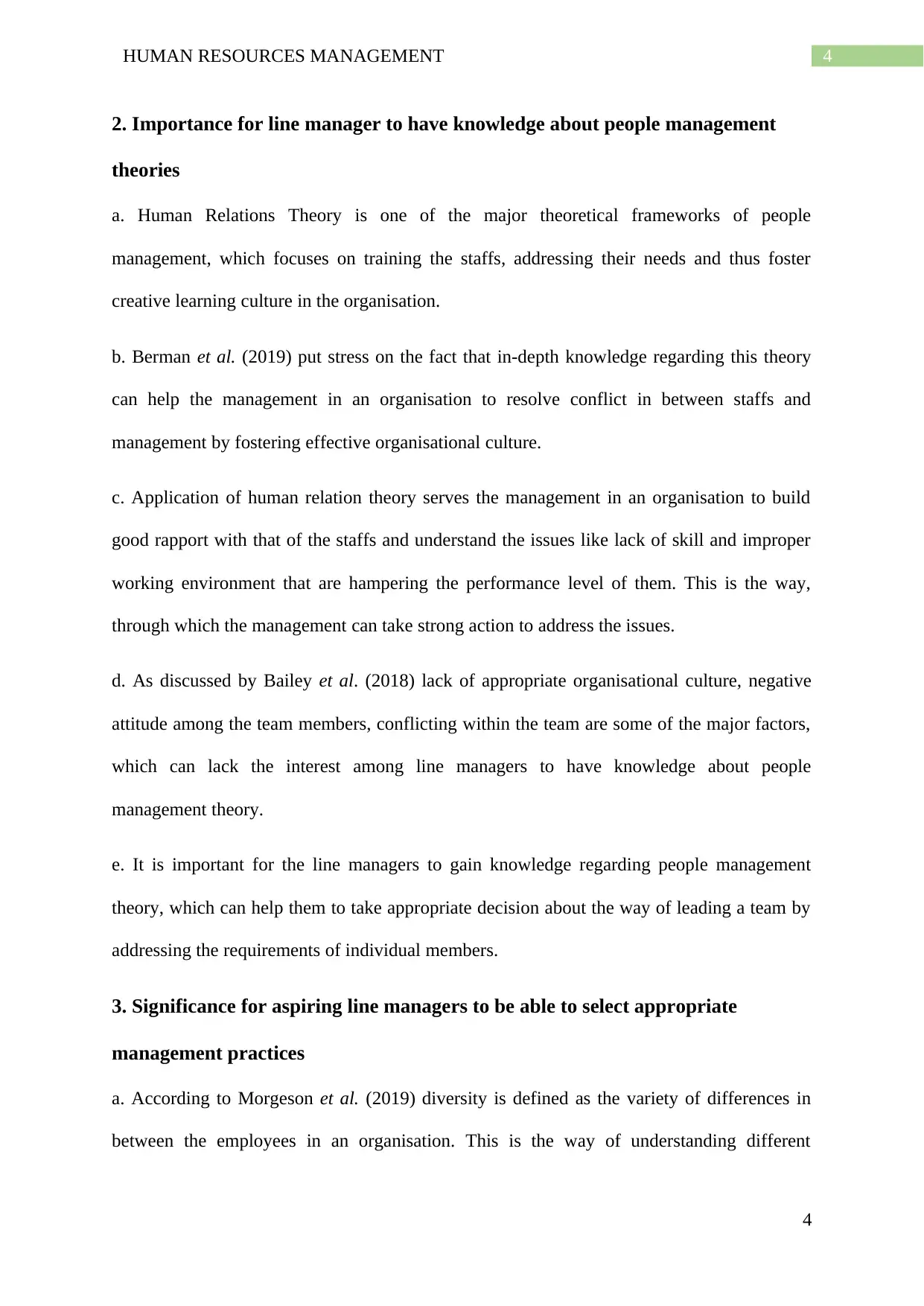
4HUMAN RESOURCES MANAGEMENT
2. Importance for line manager to have knowledge about people management
theories
a. Human Relations Theory is one of the major theoretical frameworks of people
management, which focuses on training the staffs, addressing their needs and thus foster
creative learning culture in the organisation.
b. Berman et al. (2019) put stress on the fact that in-depth knowledge regarding this theory
can help the management in an organisation to resolve conflict in between staffs and
management by fostering effective organisational culture.
c. Application of human relation theory serves the management in an organisation to build
good rapport with that of the staffs and understand the issues like lack of skill and improper
working environment that are hampering the performance level of them. This is the way,
through which the management can take strong action to address the issues.
d. As discussed by Bailey et al. (2018) lack of appropriate organisational culture, negative
attitude among the team members, conflicting within the team are some of the major factors,
which can lack the interest among line managers to have knowledge about people
management theory.
e. It is important for the line managers to gain knowledge regarding people management
theory, which can help them to take appropriate decision about the way of leading a team by
addressing the requirements of individual members.
3. Significance for aspiring line managers to be able to select appropriate
management practices
a. According to Morgeson et al. (2019) diversity is defined as the variety of differences in
between the employees in an organisation. This is the way of understanding different
4
2. Importance for line manager to have knowledge about people management
theories
a. Human Relations Theory is one of the major theoretical frameworks of people
management, which focuses on training the staffs, addressing their needs and thus foster
creative learning culture in the organisation.
b. Berman et al. (2019) put stress on the fact that in-depth knowledge regarding this theory
can help the management in an organisation to resolve conflict in between staffs and
management by fostering effective organisational culture.
c. Application of human relation theory serves the management in an organisation to build
good rapport with that of the staffs and understand the issues like lack of skill and improper
working environment that are hampering the performance level of them. This is the way,
through which the management can take strong action to address the issues.
d. As discussed by Bailey et al. (2018) lack of appropriate organisational culture, negative
attitude among the team members, conflicting within the team are some of the major factors,
which can lack the interest among line managers to have knowledge about people
management theory.
e. It is important for the line managers to gain knowledge regarding people management
theory, which can help them to take appropriate decision about the way of leading a team by
addressing the requirements of individual members.
3. Significance for aspiring line managers to be able to select appropriate
management practices
a. According to Morgeson et al. (2019) diversity is defined as the variety of differences in
between the employees in an organisation. This is the way of understanding different
4
Paraphrase This Document
Need a fresh take? Get an instant paraphrase of this document with our AI Paraphraser
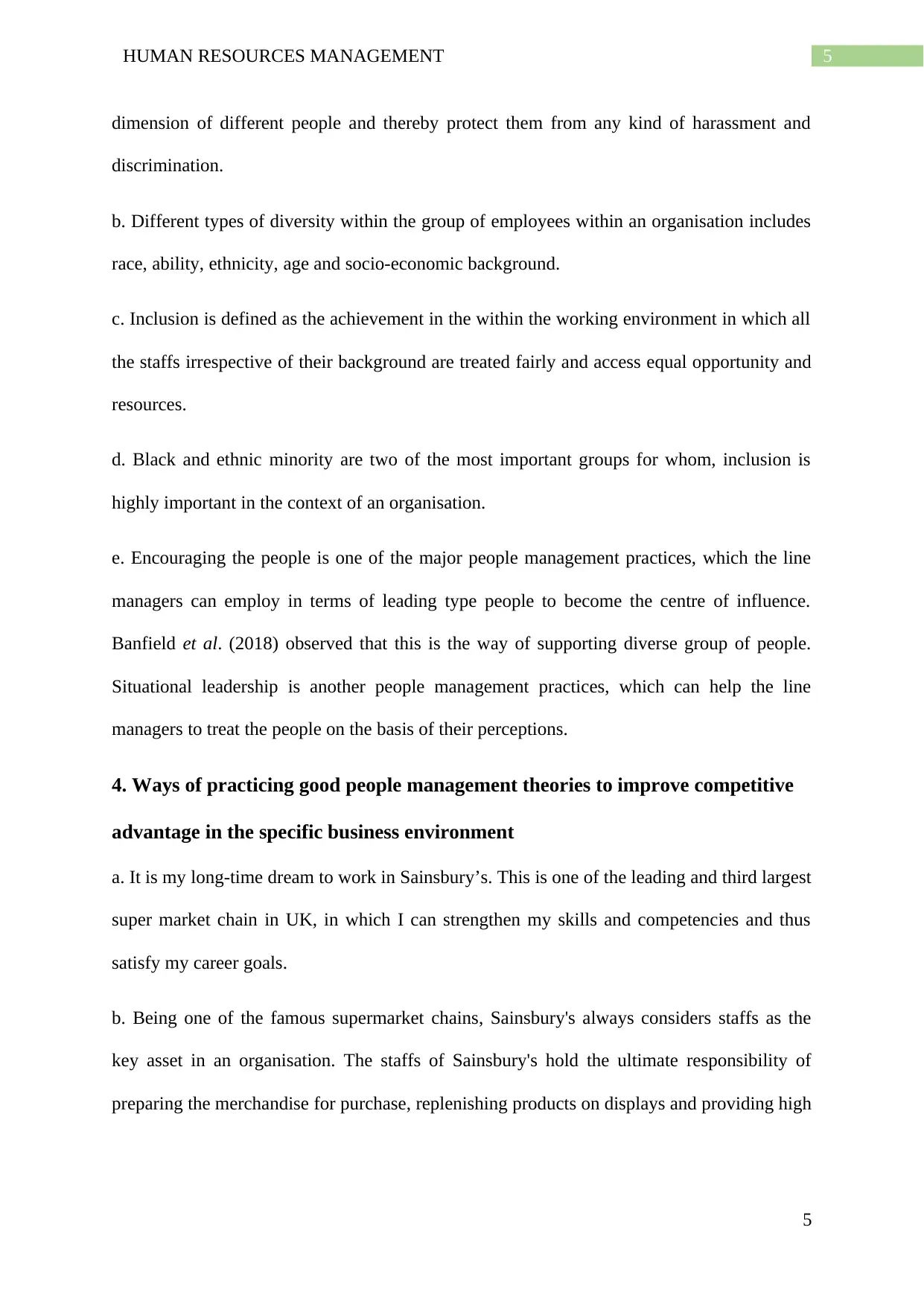
5HUMAN RESOURCES MANAGEMENT
dimension of different people and thereby protect them from any kind of harassment and
discrimination.
b. Different types of diversity within the group of employees within an organisation includes
race, ability, ethnicity, age and socio-economic background.
c. Inclusion is defined as the achievement in the within the working environment in which all
the staffs irrespective of their background are treated fairly and access equal opportunity and
resources.
d. Black and ethnic minority are two of the most important groups for whom, inclusion is
highly important in the context of an organisation.
e. Encouraging the people is one of the major people management practices, which the line
managers can employ in terms of leading type people to become the centre of influence.
Banfield et al. (2018) observed that this is the way of supporting diverse group of people.
Situational leadership is another people management practices, which can help the line
managers to treat the people on the basis of their perceptions.
4. Ways of practicing good people management theories to improve competitive
advantage in the specific business environment
a. It is my long-time dream to work in Sainsbury’s. This is one of the leading and third largest
super market chain in UK, in which I can strengthen my skills and competencies and thus
satisfy my career goals.
b. Being one of the famous supermarket chains, Sainsbury's always considers staffs as the
key asset in an organisation. The staffs of Sainsbury's hold the ultimate responsibility of
preparing the merchandise for purchase, replenishing products on displays and providing high
5
dimension of different people and thereby protect them from any kind of harassment and
discrimination.
b. Different types of diversity within the group of employees within an organisation includes
race, ability, ethnicity, age and socio-economic background.
c. Inclusion is defined as the achievement in the within the working environment in which all
the staffs irrespective of their background are treated fairly and access equal opportunity and
resources.
d. Black and ethnic minority are two of the most important groups for whom, inclusion is
highly important in the context of an organisation.
e. Encouraging the people is one of the major people management practices, which the line
managers can employ in terms of leading type people to become the centre of influence.
Banfield et al. (2018) observed that this is the way of supporting diverse group of people.
Situational leadership is another people management practices, which can help the line
managers to treat the people on the basis of their perceptions.
4. Ways of practicing good people management theories to improve competitive
advantage in the specific business environment
a. It is my long-time dream to work in Sainsbury’s. This is one of the leading and third largest
super market chain in UK, in which I can strengthen my skills and competencies and thus
satisfy my career goals.
b. Being one of the famous supermarket chains, Sainsbury's always considers staffs as the
key asset in an organisation. The staffs of Sainsbury's hold the ultimate responsibility of
preparing the merchandise for purchase, replenishing products on displays and providing high
5
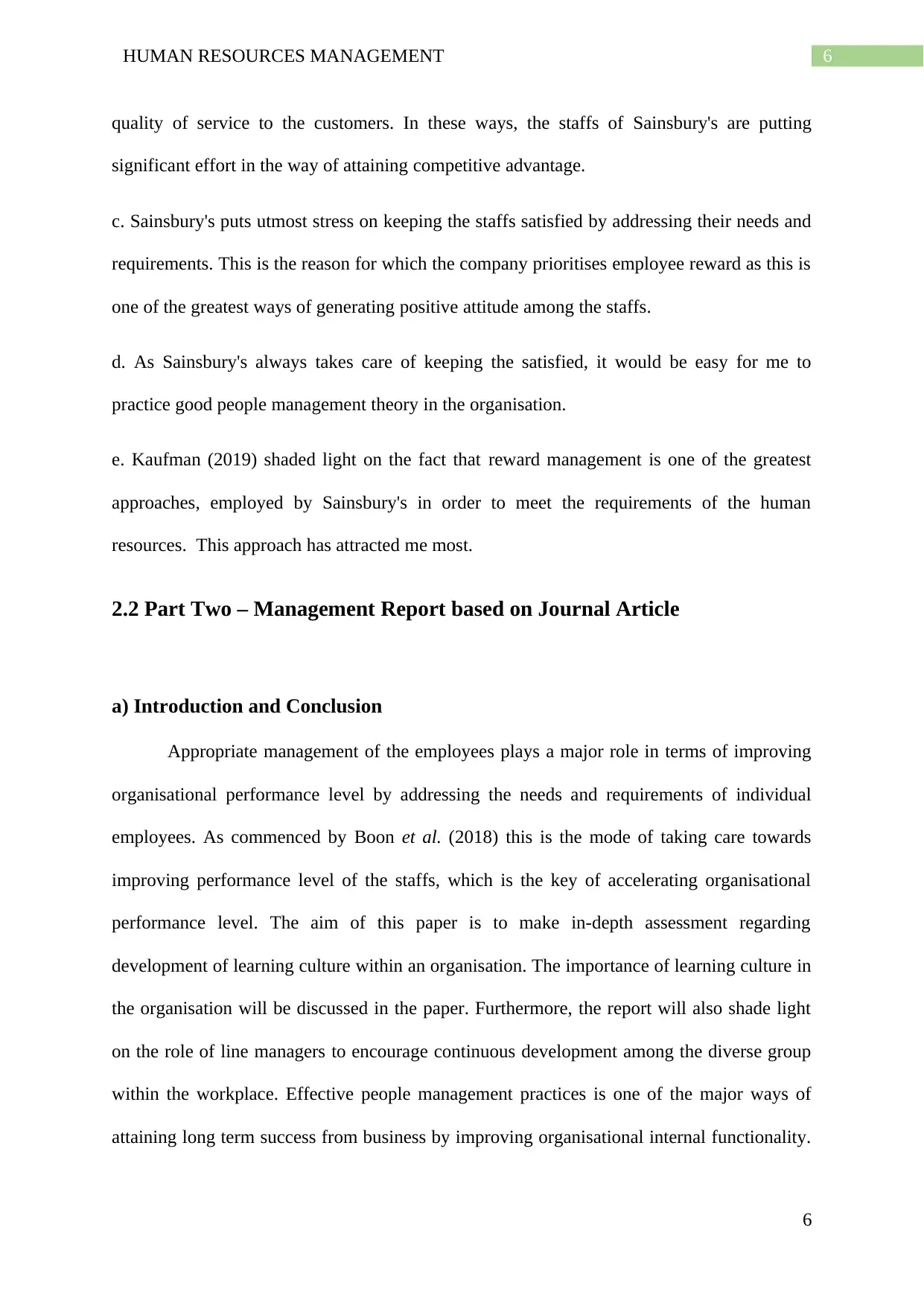
6HUMAN RESOURCES MANAGEMENT
quality of service to the customers. In these ways, the staffs of Sainsbury's are putting
significant effort in the way of attaining competitive advantage.
c. Sainsbury's puts utmost stress on keeping the staffs satisfied by addressing their needs and
requirements. This is the reason for which the company prioritises employee reward as this is
one of the greatest ways of generating positive attitude among the staffs.
d. As Sainsbury's always takes care of keeping the satisfied, it would be easy for me to
practice good people management theory in the organisation.
e. Kaufman (2019) shaded light on the fact that reward management is one of the greatest
approaches, employed by Sainsbury's in order to meet the requirements of the human
resources. This approach has attracted me most.
2.2 Part Two – Management Report based on Journal Article
a) Introduction and Conclusion
Appropriate management of the employees plays a major role in terms of improving
organisational performance level by addressing the needs and requirements of individual
employees. As commenced by Boon et al. (2018) this is the mode of taking care towards
improving performance level of the staffs, which is the key of accelerating organisational
performance level. The aim of this paper is to make in-depth assessment regarding
development of learning culture within an organisation. The importance of learning culture in
the organisation will be discussed in the paper. Furthermore, the report will also shade light
on the role of line managers to encourage continuous development among the diverse group
within the workplace. Effective people management practices is one of the major ways of
attaining long term success from business by improving organisational internal functionality.
6
quality of service to the customers. In these ways, the staffs of Sainsbury's are putting
significant effort in the way of attaining competitive advantage.
c. Sainsbury's puts utmost stress on keeping the staffs satisfied by addressing their needs and
requirements. This is the reason for which the company prioritises employee reward as this is
one of the greatest ways of generating positive attitude among the staffs.
d. As Sainsbury's always takes care of keeping the satisfied, it would be easy for me to
practice good people management theory in the organisation.
e. Kaufman (2019) shaded light on the fact that reward management is one of the greatest
approaches, employed by Sainsbury's in order to meet the requirements of the human
resources. This approach has attracted me most.
2.2 Part Two – Management Report based on Journal Article
a) Introduction and Conclusion
Appropriate management of the employees plays a major role in terms of improving
organisational performance level by addressing the needs and requirements of individual
employees. As commenced by Boon et al. (2018) this is the mode of taking care towards
improving performance level of the staffs, which is the key of accelerating organisational
performance level. The aim of this paper is to make in-depth assessment regarding
development of learning culture within an organisation. The importance of learning culture in
the organisation will be discussed in the paper. Furthermore, the report will also shade light
on the role of line managers to encourage continuous development among the diverse group
within the workplace. Effective people management practices is one of the major ways of
attaining long term success from business by improving organisational internal functionality.
6
⊘ This is a preview!⊘
Do you want full access?
Subscribe today to unlock all pages.

Trusted by 1+ million students worldwide
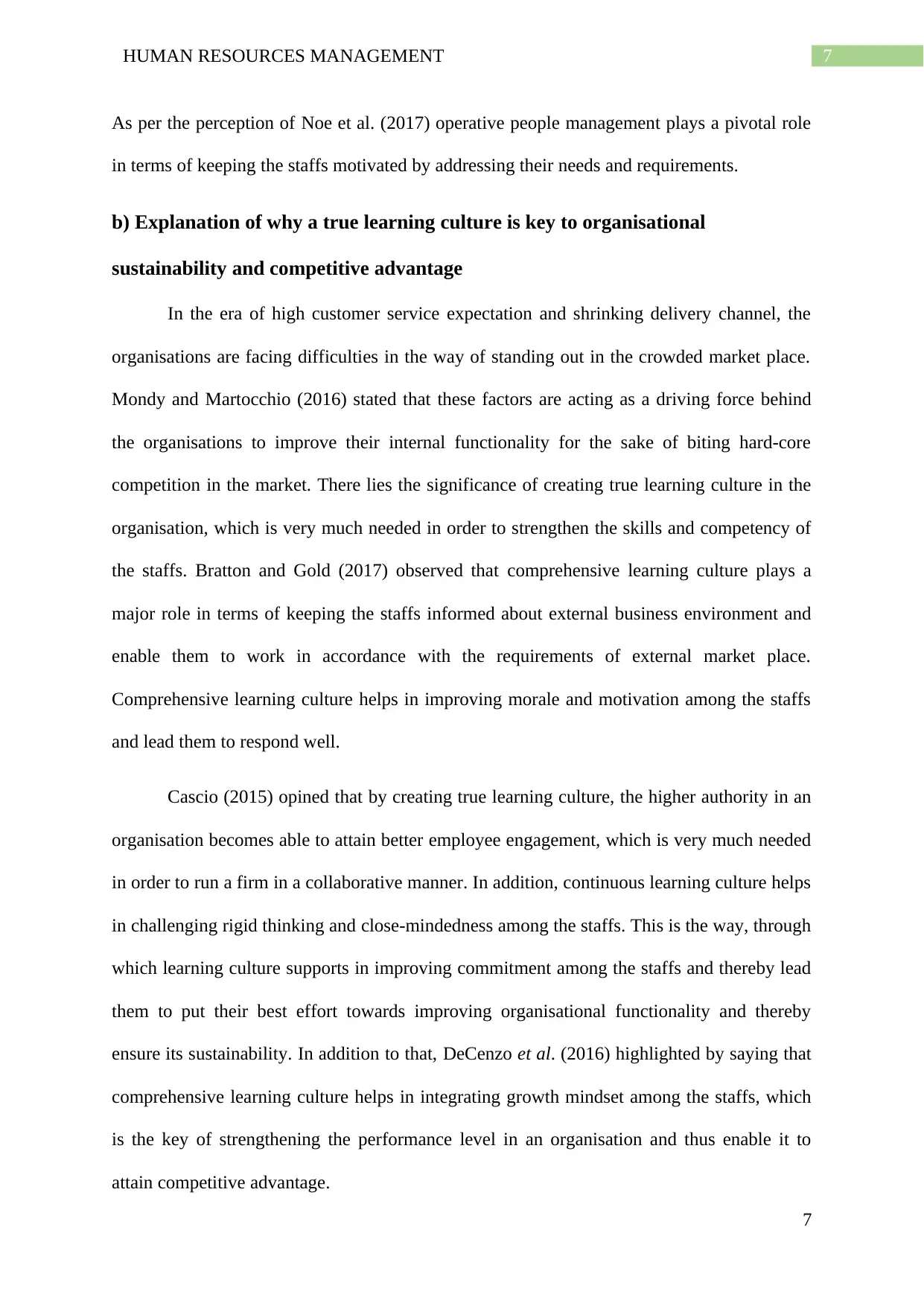
7HUMAN RESOURCES MANAGEMENT
As per the perception of Noe et al. (2017) operative people management plays a pivotal role
in terms of keeping the staffs motivated by addressing their needs and requirements.
b) Explanation of why a true learning culture is key to organisational
sustainability and competitive advantage
In the era of high customer service expectation and shrinking delivery channel, the
organisations are facing difficulties in the way of standing out in the crowded market place.
Mondy and Martocchio (2016) stated that these factors are acting as a driving force behind
the organisations to improve their internal functionality for the sake of biting hard-core
competition in the market. There lies the significance of creating true learning culture in the
organisation, which is very much needed in order to strengthen the skills and competency of
the staffs. Bratton and Gold (2017) observed that comprehensive learning culture plays a
major role in terms of keeping the staffs informed about external business environment and
enable them to work in accordance with the requirements of external market place.
Comprehensive learning culture helps in improving morale and motivation among the staffs
and lead them to respond well.
Cascio (2015) opined that by creating true learning culture, the higher authority in an
organisation becomes able to attain better employee engagement, which is very much needed
in order to run a firm in a collaborative manner. In addition, continuous learning culture helps
in challenging rigid thinking and close-mindedness among the staffs. This is the way, through
which learning culture supports in improving commitment among the staffs and thereby lead
them to put their best effort towards improving organisational functionality and thereby
ensure its sustainability. In addition to that, DeCenzo et al. (2016) highlighted by saying that
comprehensive learning culture helps in integrating growth mindset among the staffs, which
is the key of strengthening the performance level in an organisation and thus enable it to
attain competitive advantage.
7
As per the perception of Noe et al. (2017) operative people management plays a pivotal role
in terms of keeping the staffs motivated by addressing their needs and requirements.
b) Explanation of why a true learning culture is key to organisational
sustainability and competitive advantage
In the era of high customer service expectation and shrinking delivery channel, the
organisations are facing difficulties in the way of standing out in the crowded market place.
Mondy and Martocchio (2016) stated that these factors are acting as a driving force behind
the organisations to improve their internal functionality for the sake of biting hard-core
competition in the market. There lies the significance of creating true learning culture in the
organisation, which is very much needed in order to strengthen the skills and competency of
the staffs. Bratton and Gold (2017) observed that comprehensive learning culture plays a
major role in terms of keeping the staffs informed about external business environment and
enable them to work in accordance with the requirements of external market place.
Comprehensive learning culture helps in improving morale and motivation among the staffs
and lead them to respond well.
Cascio (2015) opined that by creating true learning culture, the higher authority in an
organisation becomes able to attain better employee engagement, which is very much needed
in order to run a firm in a collaborative manner. In addition, continuous learning culture helps
in challenging rigid thinking and close-mindedness among the staffs. This is the way, through
which learning culture supports in improving commitment among the staffs and thereby lead
them to put their best effort towards improving organisational functionality and thereby
ensure its sustainability. In addition to that, DeCenzo et al. (2016) highlighted by saying that
comprehensive learning culture helps in integrating growth mindset among the staffs, which
is the key of strengthening the performance level in an organisation and thus enable it to
attain competitive advantage.
7
Paraphrase This Document
Need a fresh take? Get an instant paraphrase of this document with our AI Paraphraser
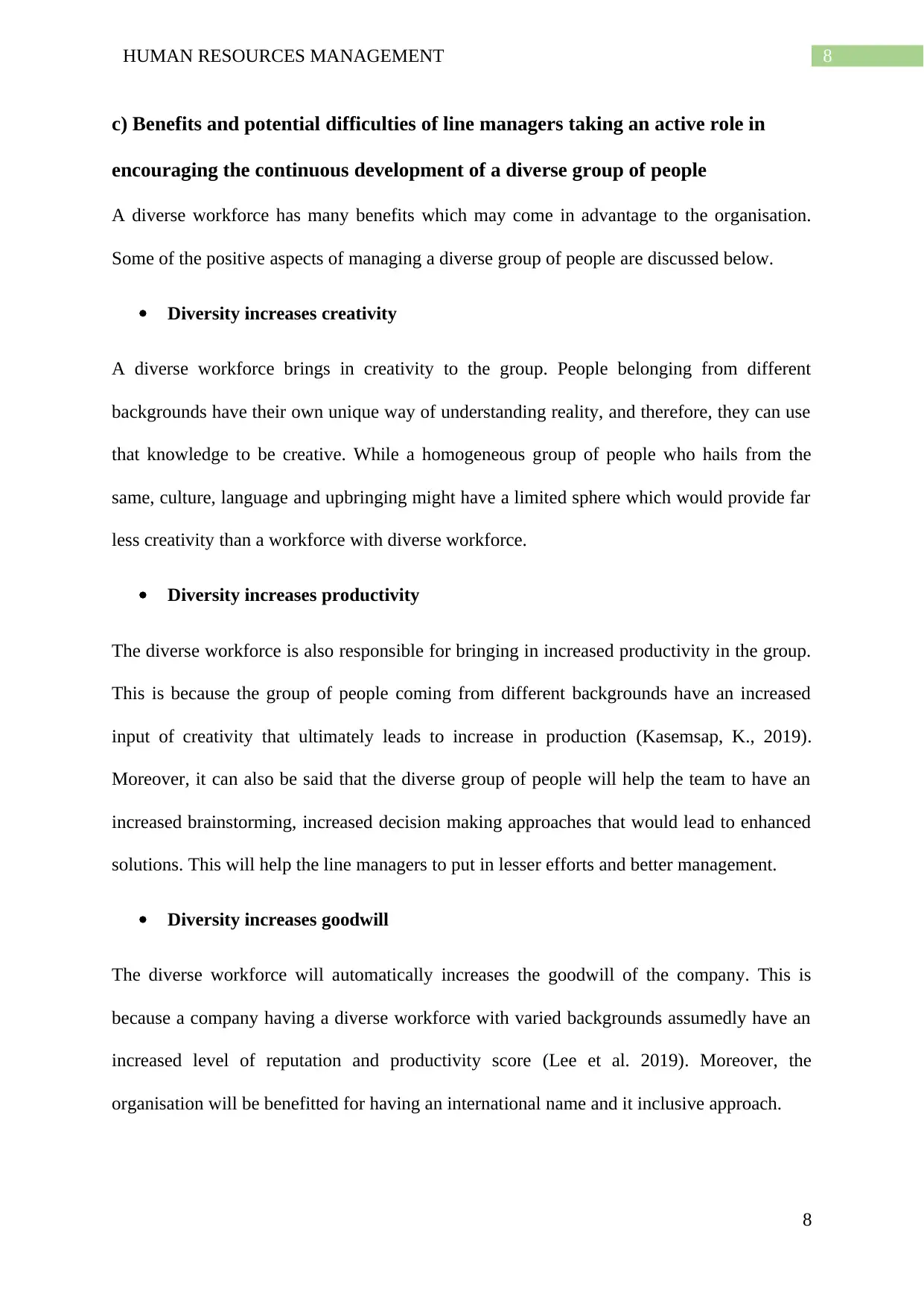
8HUMAN RESOURCES MANAGEMENT
c) Benefits and potential difficulties of line managers taking an active role in
encouraging the continuous development of a diverse group of people
A diverse workforce has many benefits which may come in advantage to the organisation.
Some of the positive aspects of managing a diverse group of people are discussed below.
Diversity increases creativity
A diverse workforce brings in creativity to the group. People belonging from different
backgrounds have their own unique way of understanding reality, and therefore, they can use
that knowledge to be creative. While a homogeneous group of people who hails from the
same, culture, language and upbringing might have a limited sphere which would provide far
less creativity than a workforce with diverse workforce.
Diversity increases productivity
The diverse workforce is also responsible for bringing in increased productivity in the group.
This is because the group of people coming from different backgrounds have an increased
input of creativity that ultimately leads to increase in production (Kasemsap, K., 2019).
Moreover, it can also be said that the diverse group of people will help the team to have an
increased brainstorming, increased decision making approaches that would lead to enhanced
solutions. This will help the line managers to put in lesser efforts and better management.
Diversity increases goodwill
The diverse workforce will automatically increases the goodwill of the company. This is
because a company having a diverse workforce with varied backgrounds assumedly have an
increased level of reputation and productivity score (Lee et al. 2019). Moreover, the
organisation will be benefitted for having an international name and it inclusive approach.
8
c) Benefits and potential difficulties of line managers taking an active role in
encouraging the continuous development of a diverse group of people
A diverse workforce has many benefits which may come in advantage to the organisation.
Some of the positive aspects of managing a diverse group of people are discussed below.
Diversity increases creativity
A diverse workforce brings in creativity to the group. People belonging from different
backgrounds have their own unique way of understanding reality, and therefore, they can use
that knowledge to be creative. While a homogeneous group of people who hails from the
same, culture, language and upbringing might have a limited sphere which would provide far
less creativity than a workforce with diverse workforce.
Diversity increases productivity
The diverse workforce is also responsible for bringing in increased productivity in the group.
This is because the group of people coming from different backgrounds have an increased
input of creativity that ultimately leads to increase in production (Kasemsap, K., 2019).
Moreover, it can also be said that the diverse group of people will help the team to have an
increased brainstorming, increased decision making approaches that would lead to enhanced
solutions. This will help the line managers to put in lesser efforts and better management.
Diversity increases goodwill
The diverse workforce will automatically increases the goodwill of the company. This is
because a company having a diverse workforce with varied backgrounds assumedly have an
increased level of reputation and productivity score (Lee et al. 2019). Moreover, the
organisation will be benefitted for having an international name and it inclusive approach.
8
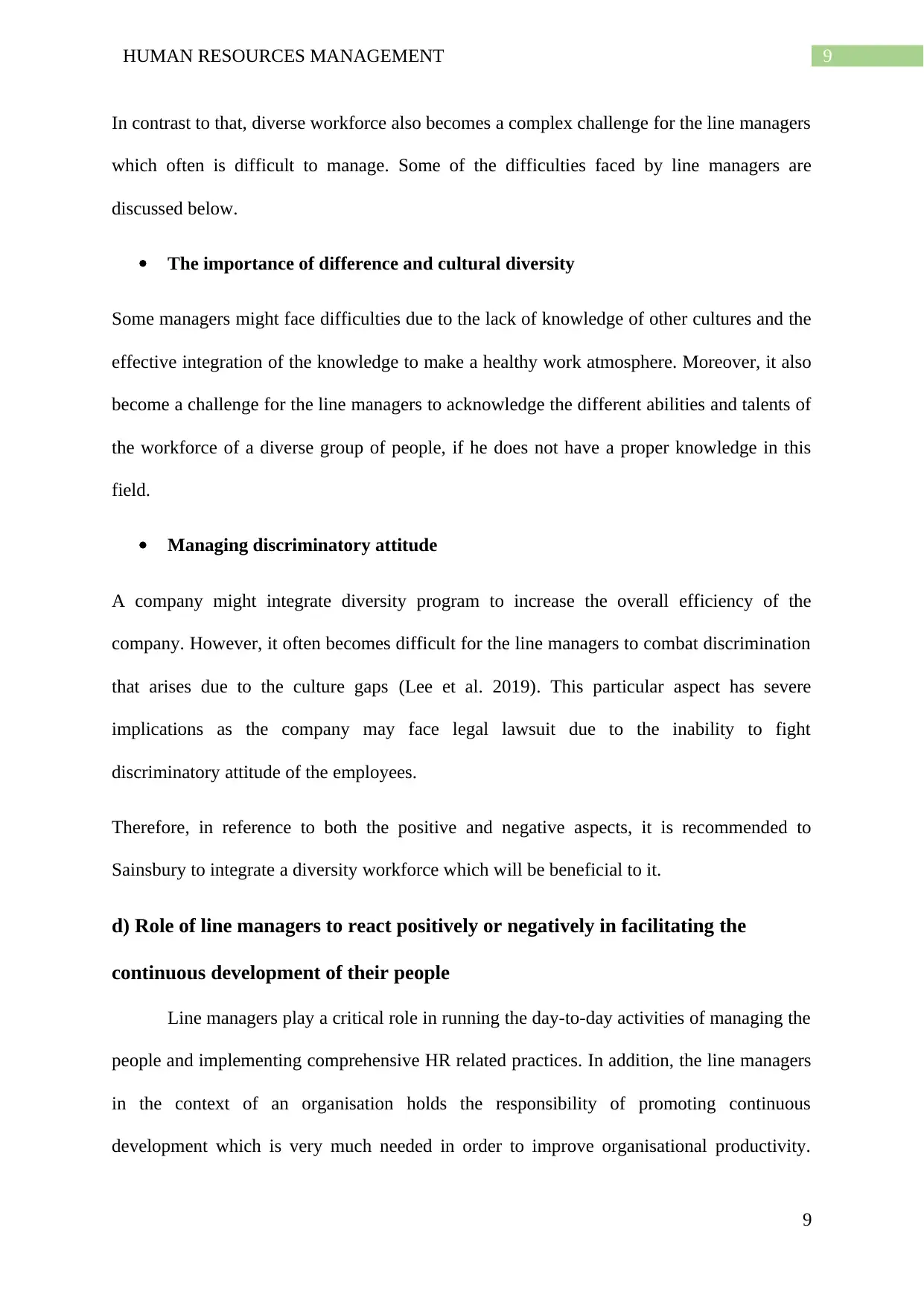
9HUMAN RESOURCES MANAGEMENT
In contrast to that, diverse workforce also becomes a complex challenge for the line managers
which often is difficult to manage. Some of the difficulties faced by line managers are
discussed below.
The importance of difference and cultural diversity
Some managers might face difficulties due to the lack of knowledge of other cultures and the
effective integration of the knowledge to make a healthy work atmosphere. Moreover, it also
become a challenge for the line managers to acknowledge the different abilities and talents of
the workforce of a diverse group of people, if he does not have a proper knowledge in this
field.
Managing discriminatory attitude
A company might integrate diversity program to increase the overall efficiency of the
company. However, it often becomes difficult for the line managers to combat discrimination
that arises due to the culture gaps (Lee et al. 2019). This particular aspect has severe
implications as the company may face legal lawsuit due to the inability to fight
discriminatory attitude of the employees.
Therefore, in reference to both the positive and negative aspects, it is recommended to
Sainsbury to integrate a diversity workforce which will be beneficial to it.
d) Role of line managers to react positively or negatively in facilitating the
continuous development of their people
Line managers play a critical role in running the day-to-day activities of managing the
people and implementing comprehensive HR related practices. In addition, the line managers
in the context of an organisation holds the responsibility of promoting continuous
development which is very much needed in order to improve organisational productivity.
9
In contrast to that, diverse workforce also becomes a complex challenge for the line managers
which often is difficult to manage. Some of the difficulties faced by line managers are
discussed below.
The importance of difference and cultural diversity
Some managers might face difficulties due to the lack of knowledge of other cultures and the
effective integration of the knowledge to make a healthy work atmosphere. Moreover, it also
become a challenge for the line managers to acknowledge the different abilities and talents of
the workforce of a diverse group of people, if he does not have a proper knowledge in this
field.
Managing discriminatory attitude
A company might integrate diversity program to increase the overall efficiency of the
company. However, it often becomes difficult for the line managers to combat discrimination
that arises due to the culture gaps (Lee et al. 2019). This particular aspect has severe
implications as the company may face legal lawsuit due to the inability to fight
discriminatory attitude of the employees.
Therefore, in reference to both the positive and negative aspects, it is recommended to
Sainsbury to integrate a diversity workforce which will be beneficial to it.
d) Role of line managers to react positively or negatively in facilitating the
continuous development of their people
Line managers play a critical role in running the day-to-day activities of managing the
people and implementing comprehensive HR related practices. In addition, the line managers
in the context of an organisation holds the responsibility of promoting continuous
development which is very much needed in order to improve organisational productivity.
9
⊘ This is a preview!⊘
Do you want full access?
Subscribe today to unlock all pages.

Trusted by 1+ million students worldwide
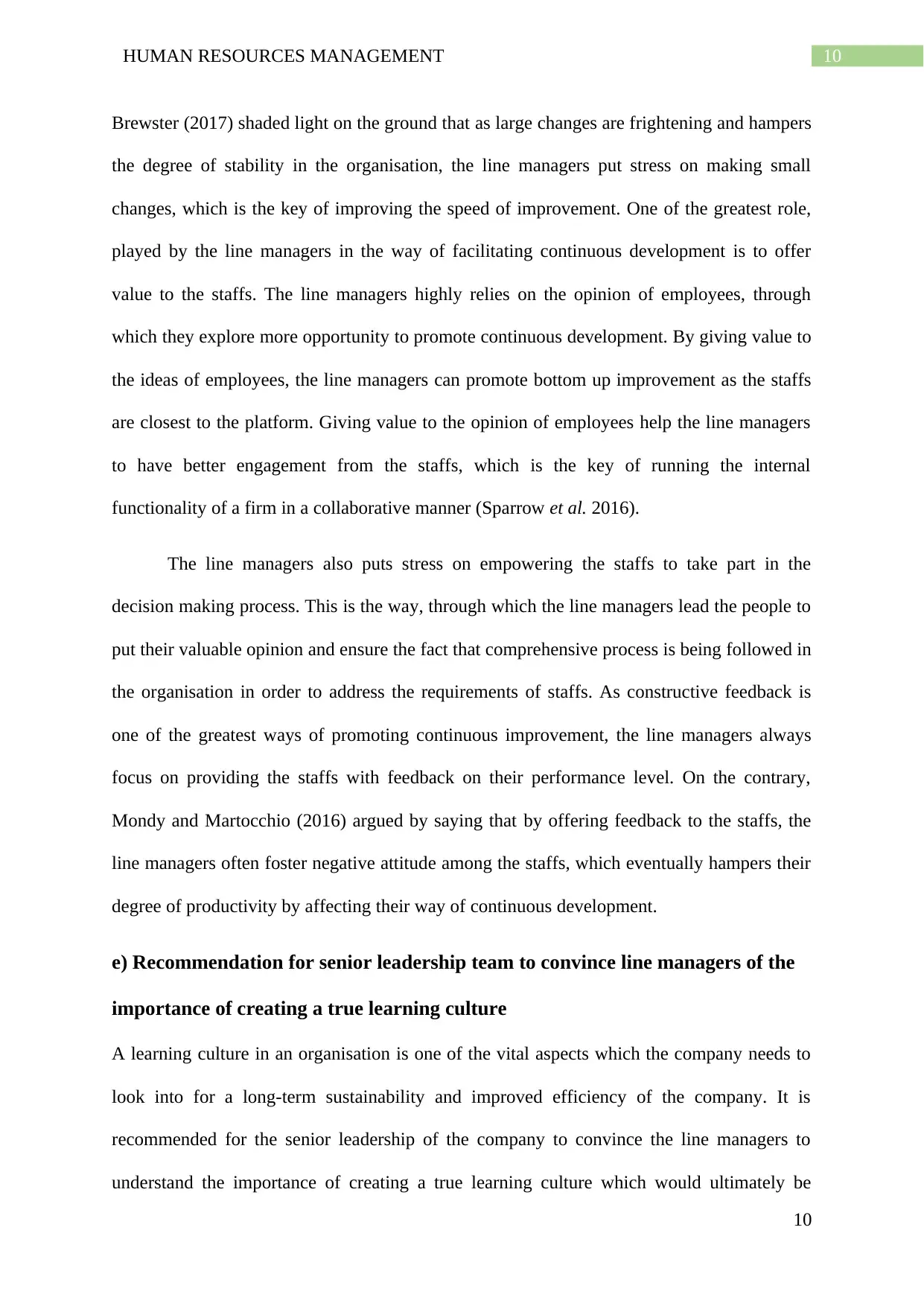
10HUMAN RESOURCES MANAGEMENT
Brewster (2017) shaded light on the ground that as large changes are frightening and hampers
the degree of stability in the organisation, the line managers put stress on making small
changes, which is the key of improving the speed of improvement. One of the greatest role,
played by the line managers in the way of facilitating continuous development is to offer
value to the staffs. The line managers highly relies on the opinion of employees, through
which they explore more opportunity to promote continuous development. By giving value to
the ideas of employees, the line managers can promote bottom up improvement as the staffs
are closest to the platform. Giving value to the opinion of employees help the line managers
to have better engagement from the staffs, which is the key of running the internal
functionality of a firm in a collaborative manner (Sparrow et al. 2016).
The line managers also puts stress on empowering the staffs to take part in the
decision making process. This is the way, through which the line managers lead the people to
put their valuable opinion and ensure the fact that comprehensive process is being followed in
the organisation in order to address the requirements of staffs. As constructive feedback is
one of the greatest ways of promoting continuous improvement, the line managers always
focus on providing the staffs with feedback on their performance level. On the contrary,
Mondy and Martocchio (2016) argued by saying that by offering feedback to the staffs, the
line managers often foster negative attitude among the staffs, which eventually hampers their
degree of productivity by affecting their way of continuous development.
e) Recommendation for senior leadership team to convince line managers of the
importance of creating a true learning culture
A learning culture in an organisation is one of the vital aspects which the company needs to
look into for a long-term sustainability and improved efficiency of the company. It is
recommended for the senior leadership of the company to convince the line managers to
understand the importance of creating a true learning culture which would ultimately be
10
Brewster (2017) shaded light on the ground that as large changes are frightening and hampers
the degree of stability in the organisation, the line managers put stress on making small
changes, which is the key of improving the speed of improvement. One of the greatest role,
played by the line managers in the way of facilitating continuous development is to offer
value to the staffs. The line managers highly relies on the opinion of employees, through
which they explore more opportunity to promote continuous development. By giving value to
the ideas of employees, the line managers can promote bottom up improvement as the staffs
are closest to the platform. Giving value to the opinion of employees help the line managers
to have better engagement from the staffs, which is the key of running the internal
functionality of a firm in a collaborative manner (Sparrow et al. 2016).
The line managers also puts stress on empowering the staffs to take part in the
decision making process. This is the way, through which the line managers lead the people to
put their valuable opinion and ensure the fact that comprehensive process is being followed in
the organisation in order to address the requirements of staffs. As constructive feedback is
one of the greatest ways of promoting continuous improvement, the line managers always
focus on providing the staffs with feedback on their performance level. On the contrary,
Mondy and Martocchio (2016) argued by saying that by offering feedback to the staffs, the
line managers often foster negative attitude among the staffs, which eventually hampers their
degree of productivity by affecting their way of continuous development.
e) Recommendation for senior leadership team to convince line managers of the
importance of creating a true learning culture
A learning culture in an organisation is one of the vital aspects which the company needs to
look into for a long-term sustainability and improved efficiency of the company. It is
recommended for the senior leadership of the company to convince the line managers to
understand the importance of creating a true learning culture which would ultimately be
10
Paraphrase This Document
Need a fresh take? Get an instant paraphrase of this document with our AI Paraphraser
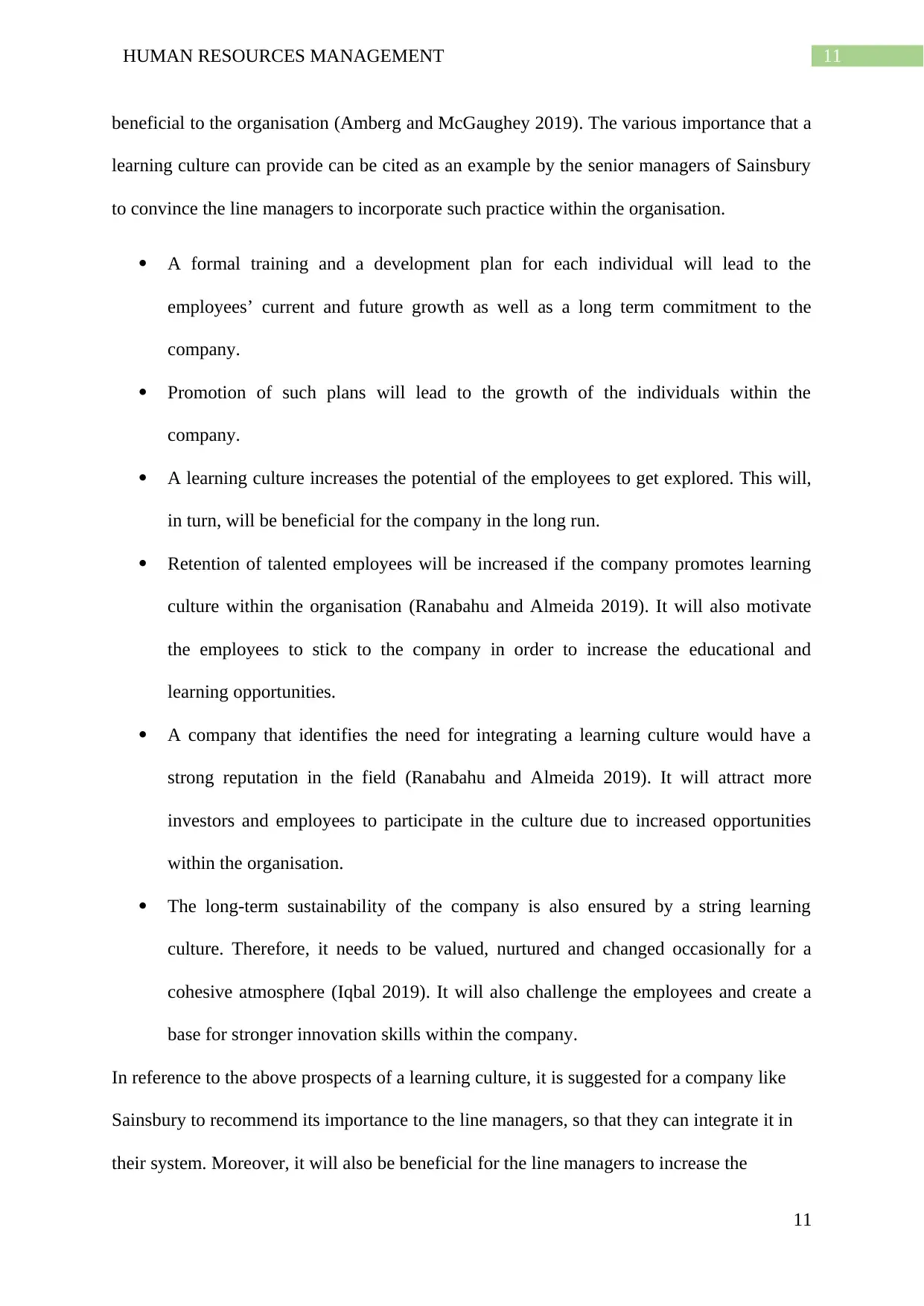
11HUMAN RESOURCES MANAGEMENT
beneficial to the organisation (Amberg and McGaughey 2019). The various importance that a
learning culture can provide can be cited as an example by the senior managers of Sainsbury
to convince the line managers to incorporate such practice within the organisation.
A formal training and a development plan for each individual will lead to the
employees’ current and future growth as well as a long term commitment to the
company.
Promotion of such plans will lead to the growth of the individuals within the
company.
A learning culture increases the potential of the employees to get explored. This will,
in turn, will be beneficial for the company in the long run.
Retention of talented employees will be increased if the company promotes learning
culture within the organisation (Ranabahu and Almeida 2019). It will also motivate
the employees to stick to the company in order to increase the educational and
learning opportunities.
A company that identifies the need for integrating a learning culture would have a
strong reputation in the field (Ranabahu and Almeida 2019). It will attract more
investors and employees to participate in the culture due to increased opportunities
within the organisation.
The long-term sustainability of the company is also ensured by a string learning
culture. Therefore, it needs to be valued, nurtured and changed occasionally for a
cohesive atmosphere (Iqbal 2019). It will also challenge the employees and create a
base for stronger innovation skills within the company.
In reference to the above prospects of a learning culture, it is suggested for a company like
Sainsbury to recommend its importance to the line managers, so that they can integrate it in
their system. Moreover, it will also be beneficial for the line managers to increase the
11
beneficial to the organisation (Amberg and McGaughey 2019). The various importance that a
learning culture can provide can be cited as an example by the senior managers of Sainsbury
to convince the line managers to incorporate such practice within the organisation.
A formal training and a development plan for each individual will lead to the
employees’ current and future growth as well as a long term commitment to the
company.
Promotion of such plans will lead to the growth of the individuals within the
company.
A learning culture increases the potential of the employees to get explored. This will,
in turn, will be beneficial for the company in the long run.
Retention of talented employees will be increased if the company promotes learning
culture within the organisation (Ranabahu and Almeida 2019). It will also motivate
the employees to stick to the company in order to increase the educational and
learning opportunities.
A company that identifies the need for integrating a learning culture would have a
strong reputation in the field (Ranabahu and Almeida 2019). It will attract more
investors and employees to participate in the culture due to increased opportunities
within the organisation.
The long-term sustainability of the company is also ensured by a string learning
culture. Therefore, it needs to be valued, nurtured and changed occasionally for a
cohesive atmosphere (Iqbal 2019). It will also challenge the employees and create a
base for stronger innovation skills within the company.
In reference to the above prospects of a learning culture, it is suggested for a company like
Sainsbury to recommend its importance to the line managers, so that they can integrate it in
their system. Moreover, it will also be beneficial for the line managers to increase the
11
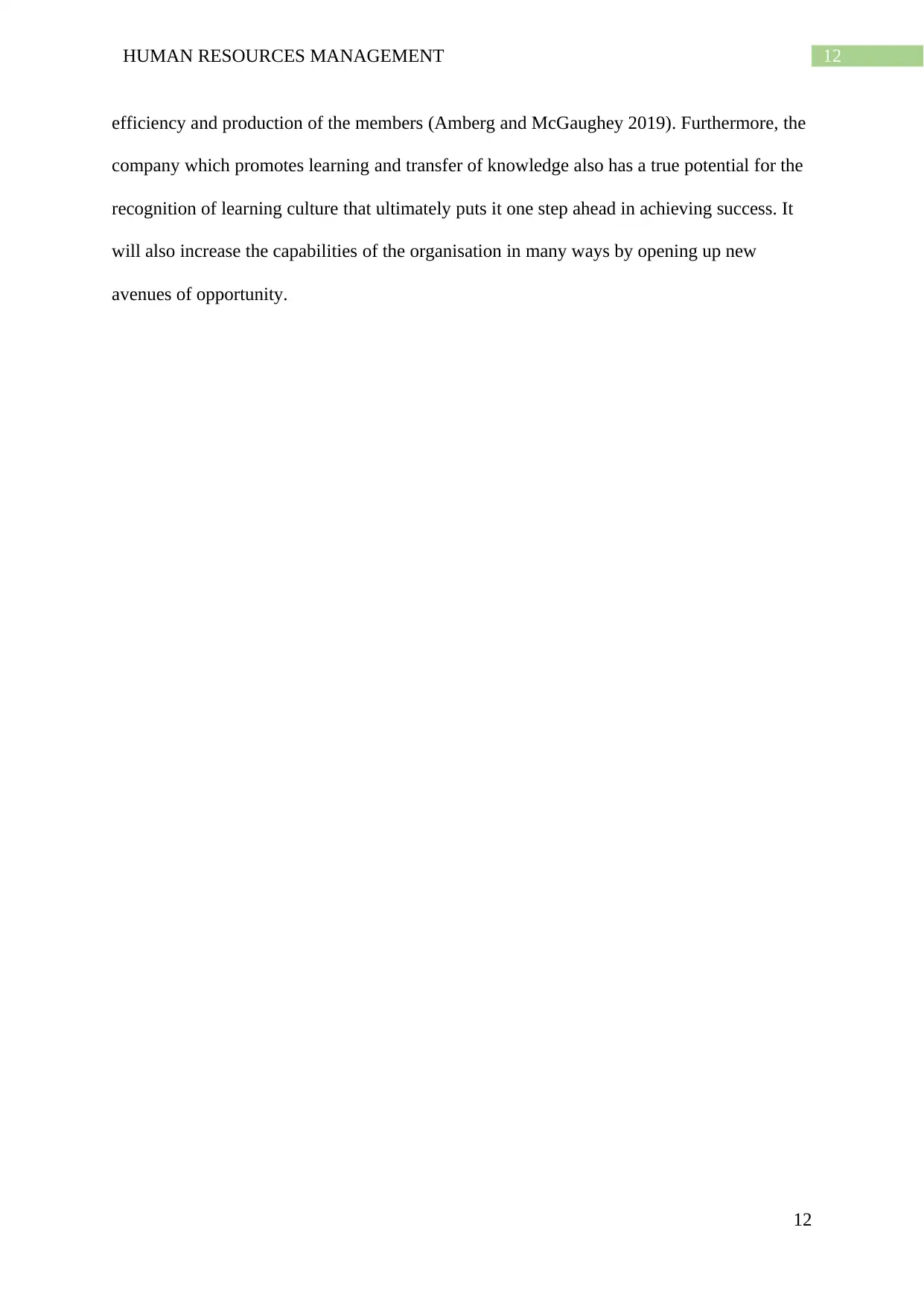
12HUMAN RESOURCES MANAGEMENT
efficiency and production of the members (Amberg and McGaughey 2019). Furthermore, the
company which promotes learning and transfer of knowledge also has a true potential for the
recognition of learning culture that ultimately puts it one step ahead in achieving success. It
will also increase the capabilities of the organisation in many ways by opening up new
avenues of opportunity.
12
efficiency and production of the members (Amberg and McGaughey 2019). Furthermore, the
company which promotes learning and transfer of knowledge also has a true potential for the
recognition of learning culture that ultimately puts it one step ahead in achieving success. It
will also increase the capabilities of the organisation in many ways by opening up new
avenues of opportunity.
12
⊘ This is a preview!⊘
Do you want full access?
Subscribe today to unlock all pages.

Trusted by 1+ million students worldwide
1 out of 15
Related Documents
Your All-in-One AI-Powered Toolkit for Academic Success.
+13062052269
info@desklib.com
Available 24*7 on WhatsApp / Email
![[object Object]](/_next/static/media/star-bottom.7253800d.svg)
Unlock your academic potential
Copyright © 2020–2025 A2Z Services. All Rights Reserved. Developed and managed by ZUCOL.





